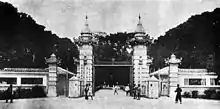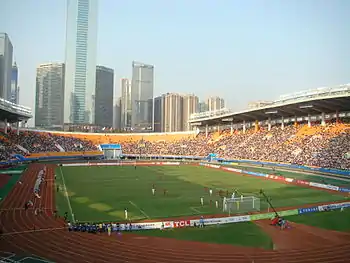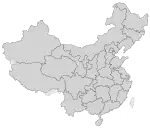Guangdong
Guangdong (alternately romanized as Canton Province or Kwangtung) is a coastal province in South China on the north shore of the South China Sea. The capital of the province is Guangzhou. With a population of 113.46 million (as of 2018[6]) across a total area of about 179,800 km2 (69,400 sq mi),[1] Guangdong is the most populous province of China and the 15th-largest by area. Its economy is larger than that of any other province in the nation and the 4th largest sub-national economy in the world with GDP of 1.66 trillion USD (10.77 trillion CNY) in 2019.[6] The Pearl River Delta Economic Zone, a Chinese megalopolis, is a core for high technology, manufacturing and foreign trade. Located in this zone are two of the four top Chinese cities and the top two Chinese prefecture-level cities by GDP; Guangzhou, the capital of the province, and Shenzhen, the first special economic zone in the country. These two are among the most populous and important cities in China, and have now become two of the world's most populous megacities.
Guangdong Province
广东省 | |
|---|---|
| Name transcription(s) | |
| • Chinese | 广东省 (Guǎngdōng Shěng) |
| • Abbreviation | GD / 粤 (pinyin: Yuè; Jyutping: Jyut6) |
From top to bottom, left to right: Canton Tower in Guangzhou, Nanshan District skyline of Shenzhen, Hong Kong–Zhuhai–Macau Bridge, Views of Mount Danxia | |
.svg.png.webp) Map showing the location of Guangdong Province | |
| Coordinates: 23°24′N 113°30′E | |
| Named for | Abbreviated from "Guǎngnándōng Lù" (A "lù" (often translated “Circuit”) was equal to a province or a state in Song China) 广 = wide, vast, expanse 东 = east literally, "At the East of the Expanse" (Guangxi being the West) |
| Capital | Guangzhou |
| Largest city | Shenzhen |
| Divisions | 21 prefectures, 121 counties, 1642 townships |
| Government | |
| • Secretary | Li Xi |
| • Governor | Ma Xingrui |
| Area | |
| • Total | 179,800 km2 (69,400 sq mi) |
| Area rank | 15th |
| Highest elevation | 1,902 m (6,240 ft) |
| Population (2018)[2] | |
| • Total | 113,460,000[3] |
| • Rank | 1st |
| • Density rank | 7th |
| Demonym(s) | Cantonese |
| Demographics | |
| • Ethnic composition | Han – 99% Zhuang – 0.7% Yao – 0.2% |
| • Languages and dialects | Cantonese and other Yue languages, Hakka, Min Nan languages (Teochew & Leizhou Min), Tuhua, Mandarin, Zhuang |
| ISO 3166 code | CN-GD |
| GDP (2019)[4] | ¥10.77 trillion $1.66 trillion |
| • Per Capita | ¥85,738 $13,190 |
| HDI (2018) | high · 4th |
| Website | www |
| Guangdong | |||||||||||||||||||||||||||||||||||||||||||||||||||||||||||||
|---|---|---|---|---|---|---|---|---|---|---|---|---|---|---|---|---|---|---|---|---|---|---|---|---|---|---|---|---|---|---|---|---|---|---|---|---|---|---|---|---|---|---|---|---|---|---|---|---|---|---|---|---|---|---|---|---|---|---|---|---|---|
.svg.png.webp) "Guangdong" in Simplified (top) and Traditional (bottom) Chinese characters | |||||||||||||||||||||||||||||||||||||||||||||||||||||||||||||
| Simplified Chinese | 广东 | ||||||||||||||||||||||||||||||||||||||||||||||||||||||||||||
| Traditional Chinese | 廣東 | ||||||||||||||||||||||||||||||||||||||||||||||||||||||||||||
| Postal | Kwangtung | ||||||||||||||||||||||||||||||||||||||||||||||||||||||||||||
| Literal meaning | "Eastern Expanse" | ||||||||||||||||||||||||||||||||||||||||||||||||||||||||||||
| |||||||||||||||||||||||||||||||||||||||||||||||||||||||||||||
| Abbreviation | |||||||||||||||||||||||||||||||||||||||||||||||||||||||||||||
| Simplified Chinese | 粤 | ||||||||||||||||||||||||||||||||||||||||||||||||||||||||||||
| Traditional Chinese | 粵 | ||||||||||||||||||||||||||||||||||||||||||||||||||||||||||||
| Literal meaning | [an ancient name for southern China's Baiyue] | ||||||||||||||||||||||||||||||||||||||||||||||||||||||||||||
| |||||||||||||||||||||||||||||||||||||||||||||||||||||||||||||
The province of Guangdong surpassed Henan and Shandong to become the most populous province in China in January 2005, registering 79.1 million permanent residents and 31 million migrants who lived in the province for at least six months of the year;[7][8] the total population was 104,303,132 in the 2010 census, accounting for 7.79 percent of Mainland China's population.[9] This makes it the most populous first-level administrative subdivision of any country outside of South Asia, as its population is surpassed only by those of the Indian states of Bihar, Maharashtra and Uttar Pradesh.[10] Its population increase since the census has been modest, the province registering 108,500,000 people in 2015.[11] Most of the historical Guangdong Province is administered by the People's Republic of China (PRC). Pratas Island in the South China Sea is part of Cijin District, Kaohsiung, Taiwan (ROC); the island was previously part of Guangdong Province before the Chinese Civil War.[12][13]
Guangdong has a diversified economy. Since 1989, Guangdong has topped the total GDP rankings among all provincial-level divisions, with Jiangsu and Shandong second and third in rank. As of 2018, Guangdong's GDP reached 1.47 trillion US dollars (CNY 9.73 trillion), exceeding that of Spain with GDP of 1.43 trillion US dollars, the 13th largest in the world.[14] The province contributes approximately 12% of the total economic output of mainland China, and is home to the production facilities and offices of a wide-ranging set of Chinese and foreign corporations. Guangdong has benefited from its proximity to the financial hub of Hong Kong, which it borders to the south. Guangdong also hosts the largest import and export fair in China, the Canton Fair, hosted in the provincial capital of Guangzhou.
After the unification of Lingnan region in the Qin dynasty, the immigrants from the Central Plains moved in and formed the local culture with a unique style. With the outward movement of the Guangdong people, the Hakka and Cantonese languages, music, cuisine, opera and tea ceremony have been spread throughout the nation, Southeast Asia and other countries. The two special administrative regions of Hong Kong and Macau fall within the scope of Guangdong cultural influence, and Guangdong culture still has profound influences on the Chinese in Singapore and Malaysia.
Name
"Guǎng" (traditional Chinese: 廣; simplified Chinese: 广) means "wide" or "vast", and has been associated with the region since the creation of Guang Prefecture in AD 226.[15] The name "Guang" ultimately came from Guangxin (廣信; 广信), an outpost established in Han dynasty near modern Wuzhou, whose name is a reference to an order by Emperor Wu of Han to "widely bestow favors and sow trust". Together, Guangdong and Guangxi are called Loeng gwong (Liangkwang; 兩廣; 两广; liǎng guǎng; léuhng gwóng) During the Song dynasty, the Two Guangs were formally separated as Guǎngnán Dōnglù (廣南東路; 广南东路; 'East Circuit in Southern Guang') and Guǎngnán Xīlù (廣南西路; 广南西路; 'West Circuit in Southern Guang'), which became abbreviated as Guǎngdōng Lù (廣東路; 广东路) and Guǎngxī Lù (廣西路; 广西路).
"Canton", though etymologically derived from Cantão (the Portuguese transliteration of "Guangdong"), usually by itself refers to the provincial capital Guangzhou.[16][17] Historically, Canton was also used for the province itself,[18] but often either specified as a province (e.g. Canton Province), or written as Kwangtung in the Wade–Giles system and now most commonly as Guangdong in Pinyin.[19] The local people of the city of Guangzhou (Canton) and their language are called Cantonese in English. Because of the prestige of Canton and its accent, Cantonese sensu lato can also be used for the phylogenetically related residents and Chinese dialects outside the provincial capital.
History

Prehistory
The Neolithic era began in the Pearl River Delta (珠江三角洲) 7,000 years before present (BP), with the early period from around 7000 to 5000 BP (c. 5050–3050 BC), and the late period from about 5000 to 3500 BP (c. 3050–1550 BC). In coastal Guangdong, the Neolithic was likely introduced from the middle Yangtze River area (Jiao 2013). In inland Guangdong, the neolithic appeared in Guangdong 4,600 years before present (BP). The Neolithic in northern inland Guangdong is represented by the Shixia culture (石峽文化), which occurred from 4600 to 4200 BP (c. 2650–2250 BC).[20]
Imperial
Originally inhabited by a mixture of tribal groups known to the Chinese as the Baiyue ("Hundred Yue"), the region first became part of China during the Qin dynasty. Under the Qin Dynasty, Chinese administration began and along with it reliable historical records in the region. After establishing the first unified Chinese empire, the Qin expanded southwards and set up Nanhai Commandery at Panyu, near what is now part of Guangzhou. The region was an independent kingdom as Nanyue between the fall of Qin and the reign of Emperor Wu of Han. The Han dynasty administered Guangdong, Guangxi, and northern Vietnam as Jiaozhi Province, southernmost Jiaozhi Province was used as a gateway for traders from the west—as far away as the Roman Empire. Under the Wu Kingdom of the Three Kingdoms period, Guangdong was made its own province, the Guang Province, in 226 CE.
Once known as Canton, the town was a prosperous port city along a tropical frontier region beset by disease and wild animals, but rich in oranges, banyan, bananas, and lychee fruits, they traded slaves, silk and chinaware with Persians, Brahmans and Malays in exchange for their renowned medicines and fragrant tropical woods. Shi'a Muslims who had fled persecution in Khorasan and Buddhists from India lived side by side in the thriving town each erecting their own houses of worship. A foreign quarter sprang up along the river where many traders of diverse backgrounds including Arabs, and Singhalese took up residence.[21]
The port's importance declined after it was raided by Arabs and Persians in 758 and the foreign residents were at times troubled by the corrupt local officials, sometimes responding violently. During one incident in 684, for example, a merchant vessel's captain murdered a corrupt governor who had used his position to steal from the merchant.[21]
Together with Guangxi, Guangdong was made part of Lingnan Circuit (political division Circuit), or Mountain-South Circuit, in 627 during the Tang dynasty. The Guangdong part of Lingnan Circuit was renamed Guangnan East Circuit (廣南東路) in 971 during the Song dynasty (960–1279). "Guangnan East" (廣南東) is the source of the name "Guangdong" (廣東; 广东).[22]:227
As time passed, the demographics of what is now Guangdong gradually shifted to (Han) Chinese dominance as the populations intermingled due to commerce along the great canals, and abruptly shifted through massive migration from the north during periods of political turmoil and nomadic incursions from the fall of the Han dynasty onwards. For example, internal strife in northern China following the rebellion of An Lushan resulted in a 75% increase in the population of Guangzhou prefecture between the 740s–750s and 800s–810s.[23] As more migrants arrived, the local population was gradually assimilated to Han Chinese culture[24] or displaced.
As Mongols from the north engaged in their conquest of China in the 13th century, the Southern Song court fled southwards from its capital in Hangzhou. The defeat of the Southern Song court by Mongol naval forces in The Battle of Yamen 1279 in Guangdong marked the end of the Southern Song dynasty (960–1279).[25]
During the Mongol Yuan dynasty, large parts of current Guangdong belonged to Jiangxi.[26] Its present name, "Guangdong Province" was given in early Ming dynasty.
Since the 16th century, Guangdong has had extensive trade links with the rest of the world. European merchants coming northwards via the Straits of Malacca and the South China Sea, particularly the Portuguese and British, traded extensively through Guangzhou. Macau, on the southern coast of Guangdong, was the first European settlement in 1557.
In the 19th century, the opium traded through Guangzhou triggered the First Opium War, opening an era of Western imperialists' incursion and intervention in China. In addition to Macau, which was then a Portuguese colony, Hong Kong was ceded to the British, and Kwang-Chou-Wan (modern day area of Zhanjiang) to the French.
Due to the large number of people that emigrated out of the Guangdong province, and in particular the ease of immigration from Hong Kong to other parts of the British Empire (later British Commonwealth), many overseas Chinese communities have their origins in Guangdong and/or Cantonese culture. In particular, the Cantonese, Hakka, Teochew dialects have proportionately more speakers among overseas Chinese people than Mandarin-speaking Chinese. Additionally, many Taishanese-speaking Chinese emigrated to Western countries, with the results that many Western versions of Chinese words were derived from the Cantonese dialects rather than through the mainstream Mandarin language, such as "dim sum". Some Mandarin Chinese words originally of foreign origin also came from the original foreign language by way of Cantonese. For example, the Mandarin word níngméng (simplified Chinese: 柠檬; traditional Chinese: 檸檬), meaning "Lemon", came from Cantonese, in which the characters are pronounced as lìng mung.[27] In the United States, there is a large number of Chinese who are descendants of immigrants from the county-level city of Taishan (Toisan in Cantonese), who speak a distinctive dialect related to Cantonese called Taishanese (or Toishanese).
During the 1850s, the Taiping Heavenly Kingdom, whose leader Hong Xiuquan was born in Guangdong and received a pamphlet from a Protestant Christian missionary in Guangdong, was allied with a local Guangdong Red Turban Rebellion (1854–1856). Because of direct contact with the West, Guangdong was the center of anti-Manchu and anti-imperialist activity. The generally acknowledged founder of modern China, Sun Yat-sen, was also from Guangdong.
20th century
During the early 1920s of the Republic of China, Guangdong was the staging area for the Kuomintang (KMT) to prepare for the Northern Expedition, an effort to bring the various warlords of China back under a unified central government. Whampoa Military Academy was built near Guangzhou to train military commanders.
In recent years, the province has seen extremely rapid economic growth, aided in part by its close trading links with Hong Kong, which borders it. It is now the province with the highest gross domestic product in China.
In 1952, a small section of Guangdong's coastline (Qinzhou, Lianzhou (now Hepu County), Fangchenggang and Beihai) was given to Guangxi, giving it access to the sea. This was reversed in 1955, and then restored in 1965. Hainan Island was originally part of Guangdong, but it was separated into its own province in 1988.
Geography
Guangdong faces the South China Sea to the south and has a total of 4,300 km (2,700 mi) of coastline. The Leizhou Peninsula is on the southwestern end of the province. There are a few inactive volcanoes on Leizhou Peninsula. The Pearl River Delta is the convergent point of three upstream rivers: the East River, North River, and West River. The river delta is filled with hundreds of small islands. The province is geographically separated from the north by a few mountain ranges collectively called the Nan Mountains (Nan Ling). The highest peak in the province is Shikengkong with an elevation of 6,240 feet (1,902 meters) above sea level.
Guangdong borders Fujian to the northeast, Jiangxi and Hunan to the north, Guangxi autonomous region to the west, and Hong Kong and Macau Special Administrative Regions to the south. Hainan is offshore across from the Leizhou Peninsula. Pratas Island, which were traditionally governed as part of Guangdong, are part of Cijin District, Kaoshiung, Taiwan (ROC).[28]
Cities around the Pearl River Delta include Dongguan, Foshan, Guangzhou, Huizhou, Jiangmen, Shenzhen, Shunde, Taishan, Zhongshan and Zhuhai. Other cities in the province include Chaozhou, Chenghai, Nanhai, Shantou, Shaoguan, Zhanjiang, Zhaoqing, Yangjiang and Yunfu.
Guangdong has a humid subtropical climate (Köppen Cfa inland, Cwa along the coast). Winters are short, mild, and relatively dry, while summers are long, hot, and very wet. Average daily highs in Guangzhou in January and July are 18 °C (64 °F) and 33 °C (91 °F), although the humidity makes it feel hotter in summer. Frost is rare on the coast but may happen a few days each winter.
Economy
In 2019, the gross domestic product (GDP) is about $1.6 trillion, Guangdong has been the largest province by GDP since 1989 in Mainland China. Guangdong is responsible for 11 percent of the China' $14.4 trillion GDP.[4] In 2019, Guangdong's GDP was slightly larger than that of Spain ranking 13th. Comparable to that of country subdivisions in dollar terms, Guangdong's GDP is larger than that of all but 3 country subdivisions: California, Texas and New York.

This is a trend of official estimates of the gross domestic product of the Province of Guangdong with figures in millions of Chinese Yuan:
| Historical GDP of Guangdong Province for 1978 –present (SNA2008)[29] (purchasing power parity of Chinese Yuan, as Int'l.dollar based on IMF WEO October 2017[30]) | |||||||||
| year | GDP | GDP per capita (GDPpc) based on mid-year population |
Reference index | ||||||
| GDP in millions | real growth (%) |
GDPpc | exchange rate 1 foreign currency to CNY | ||||||
| CNY | USD | PPP (Int'l$.) |
CNY | USD | PPP (Int'l$.) |
USD 1 | Int'l$. 1 (PPP) | ||
| 2016 | 8,085,491 | 1,217,273 | 2,306,121 | 7.5 | 74,016 | 11,143 | 21,111 | 6.6423 | 3.5061 |
| 2015 | 7,402,743 | 1,188,546 | 2,085,809 | 8.0 | 68,629 | 11,019 | 19,337 | 6.2284 | 3.5491 |
| 2014 | 6,890,143 | 1,121,662 | 1,940,721 | 7.8 | 64,491 | 10,499 | 18,165 | 6.1428 | 3.5503 |
| 2013 | 6,345,544 | 1,024,599 | 1,774,034 | 8.5 | 59,756 | 9,649 | 16,706 | 6.1932 | 3.5769 |
| 2012 | 5,799,354 | 918,710 | 1,633,253 | 8.2 | 54,973 | 8,709 | 15,482 | 6.3125 | 3.5508 |
| 2011 | 5,395,920 | 835,437 | 1,539,273 | 10.0 | 51,523 | 7,977 | 14,698 | 6.4588 | 3.5055 |
| 2010 | 4,657,712 | 688,044 | 1,406,909 | 12.4 | 45,284 | 6,689 | 13,678 | 6.7695 | 3.3106 |
| 2005 | 2,272,329 | 277,394 | 794,799 | 14.1 | 24,828 | 3,031 | 8,684 | 8.1917 | 2.8590 |
| 2000 | 1,081,021 | 130,583 | 397,536 | 11.5 | 12,818 | 1,548 | 4,714 | 8.2784 | 2.7193 |
| 1990 | 155,903 | 32,594 | 91,568 | 11.6 | 2,484 | 519 | 1,459 | 4.7832 | 1.7026 |
| 1980 | 24,965 | 16,661 | 16,693 | 16.6 | 481 | 321 | 322 | 1.4984 | 1.4955 |
| 1978 | 18,585 | 11,039 | 1.0 | 370 | 220 | 1.6836 | |||
After the communist revolution and until the start of the Deng Xiaoping reforms in 1978, Guangdong was an economic backwater, although a large underground, service-based economy has always existed. Economic development policies encouraged industrial development in the interior provinces which were weakly joined to Guangdong via transportation links. The government policy of economic autarky made Guangdong's access to the ocean irrelevant.
Deng Xiaoping's open door policy radically changed the economy of the province as it was able to take advantage of its access to the ocean, proximity to Hong Kong, and historical links to overseas Chinese. In addition, until the 1990s when the Chinese taxation system was reformed, the province benefited from the relatively low rate of taxation placed on it by the central government due to its post-Liberation status of being economically backward.
Guangdong's economic boom began with the early 1990s and has since spread to neighboring provinces, and also pulled their populations inward. The economic growth of Guangdong province owes much to the low-value-added manufacturing which characterized (and in many ways still defines) the province's economy following Deng Xiaoping's reforms. Guangdong is not only China's largest exporter of goods, it is the country's largest importer as well.[31]
The province is now one of the richest in the nation, with the most billionaires in mainland China,[32] the highest GDP among all the provinces, although wage growth has only recently begun to rise due to a large influx of migrant workers from neighboring provinces. In 2011, Guangdong's aggregate nominal GDP reached 5.30 trillion RMB (US$838.60 billion) with a per capita GDP of 47,689 RMB.[33] By 2015, the local government of Guangdong hopes that the service industry will account for more than 50 percent of the provinces GDP and high-tech manufacturing another 20 percent.[31]
In 2009, Guangdong's primary, secondary, and tertiary industries were worth 201 billion yuan, 1.93 trillion yuan, and 1.78 trillion yuan, respectively.[34] Its per capita GDP reached 40,748 yuan (about US$5,965).[35] Guangdong contributes approximately 12% of the total national economic output.[36] Now, it has three of the six Special Economic Zones: Shenzhen, Shantou and Zhuhai. The affluence of Guangdong, however, remains very concentrated near the Pearl River Delta.
In 2008 its foreign trade also grew 7.8% from the previous year and is also by far the largest of all of China. By numbers, Guangdong's foreign trade accounts for more than a quarter of China's US$2.56 trillion foreign trade or roughly US$683 billion.[37]
Economic and technological development zones
- Shenzhen Export Processing Zone
- Shenzhen Futian Free Trade Zone[38]
- Shenzhen Hi-Tech Industrial Park
- Yantian Port Free Trade Zone
- Foshan National New & Hi-Tech Industrial Development Zone[39]
- Guangzhou Development District
- Guangzhou Export Processing Zone
- Guangzhou Free Trade Zone
- Guangzhou Nansha Economic and Technical Development Zone
- Guangzhou Nanhu Lake Tourist Holiday Resort (Chinese Version)
- Guangzhou New & Hi-Tech Industrial Development Zone
- Huizhou Dayawan Economic and Technological Development Zone
- Huizhou Export Processing Zone
- Huizhou Zhongkai Hi-Tech Development Zone
- Nansha Free Trade Zone
- Shantou Free Trade Zone
- Shatoujiao Free Trade Zone
- Zhanjiang Economic and Technological Development Zone (Chinese Version)
- Zhuhai National Hi-Tech Industrial Development Zone
- Zhuhai Free Trade Zone
- Zhongshan Torch High-tech Industrial Development Zone
Demographics
| Year | Pop. | ±% |
|---|---|---|
| 1912[40] | 28,011,000 | — |
| 1928[41] | 32,428,000 | +15.8% |
| 1936-37[42] | 32,453,000 | +0.1% |
| 1947[43] | 27,210,000 | −16.2% |
| 1954[44] | 34,770,059 | +27.8% |
| 1964[45] | 42,800,849 | +23.1% |
| 1982[46] | 59,299,220 | +38.5% |
| 1990[47] | 62,829,236 | +6.0% |
| 2000[48] | 85,225,007 | +35.6% |
| 2010[49] | 104,303,132 | +22.4% |
| Hainan Province part of Guangdong Province until 1988. Guangzhou part of Guangdong Province until 1947; dissolved in 1954 and incorporated into Guangdong Province. | ||
Guangdong officially became the most populous province in 2005.[7][8] Official statistics had traditionally placed Guangdong as the 4th-most populous province of China with about 80 million people, though an influx of migrants, temporary workers, and newly settled individuals numbered around 30 million.[50] The massive influx of migrants from other provinces, dubbed the "floating population", is due to Guangdong's booming economy and high demand for labor. If Guangdong were an independent nation, it would rank among the twenty largest countries of the world by population.
Urbanization

Guangdong's population is 70.7% urban and 29.3% rural.[3]
Genealogy
Guangdong is the ancestral home of large numbers of overseas Chinese. Most of the railroad laborers in Canada, Western United States and Panama in the 19th century came from Guangdong. Many people from the region also travelled to the US / California during the gold rush of 1849, and also to Australia during its gold rush a decade or so later.
The majority of the province's population is Han Chinese. Within the Han Chinese, the largest subgroup in Guangdong are the Cantonese people. Two other major groups are the Teochew people in Chaoshan and the Hakka people in Huizhou, Meizhou, Heyuan, Shaoguan and Zhanjiang. There is a small Yao population in the north. Other smaller minority groups include She, Miao, Li, and Zhuang.
Gender ratio
Guangdong has a highly unbalanced gender ratio that is among the highest of all provinces in China. According to a 2009 study published in the British Medical Journal, in the 1–4 age group, there are over 130 boys for every 100 girls.[51]
Religion
Religion in Guangdong (2012)[52]
According to a 2012 survey[52] only around 7% of the population of Guangdong belongs to organised religions, the largest groups being Buddhists with 6.2%, followed by Protestants with 0.8% and Catholics with 0.2%. Around 93% of the population is either irreligious or may be involved in Chinese folk religions worshipping nature gods, ancestral deities, popular sects, Taoist traditions, Buddhist religious traditions & Confucian religious traditions.
According to a survey conducted in 2007, 43.71% of the population believes and is involved in ancestor veneration,[54] the traditional Chinese religion of the lineages organised into lineage churches and ancestral shrines.




Politics
Guangdong is governed by a dual-party system like the rest of China. The Governor is in charge of provincial affairs; however, the Communist Party Secretary, often from outside of Guangdong, keeps the Governor in check.
Relations with Hong Kong and Macau
Hong Kong and Macau, while historically parts of Guangdong before becoming colonies of the United Kingdom and Portugal, respectively, are special administrative regions (SARs). Furthermore, the Basic Laws of both SARs explicitly forbid provincial governments from intervening in local politics. As a result, many issues with Hong Kong and Macau, such as border policy and water rights, have been settled by negotiations between the SARs' governments and the Guangdong provincial government.
Media
Guangdong and the greater Guangzhou area are served by several Radio Guangdong stations, Guangdong Television, Southern Television Guangdong, Shenzhen Television, and Guangzhou Television. There is an English programme produced by Radio Guangdong which broadcasts information about this region to the entire world through the WRN Broadcast.
Culture
The central region, which is also the political and economic center, is populated predominantly by Yue Chinese speakers, though the influx in the last three decades of millions of Mandarin-speaking immigrants has slightly diminished Cantonese linguistic dominance. This region is associated with Cantonese cuisine. Cantonese opera is a form of Chinese opera popular in Cantonese speaking areas. Related Yue dialects are spoken in most of the western half of the province.
The area comprising the cities of Chaozhou, Shantou and Jieyang in coastal east Guangdong, known as Chaoshan, forms its own cultural sphere. The Teochew people here, along with Hailufeng Min people in Shanwei, speak Hokkien, which is a Min dialect closely related to mainstream Southern Min (Hokkien) and their cuisine is Teochew cuisine. Teochew opera is also well-known and has a unique form.
The Hakka people live in large areas of Guangdong, including Huizhou, Meizhou, Shenzhen, Heyuan, Shaoguan and other areas. Much of the Eastern part of Guangdong is populated by the Hakka people except for the Chaozhou and Hailufeng area. Hakka culture include Hakka cuisine, Han opera (simplified Chinese: 汉剧; traditional Chinese: 漢劇), Hakka Hanyue and sixian (traditional instrumental music) and Hakka folk songs (客家山歌).
The outcast Tanka people traditionally live on boats throughout the coasts and rivers of Guangdong and much of Southern China.
Zhanjiang in southern Guangdong is dominated by the Leizhou dialect, a variety of Minnan; Cantonese and Hakka are also spoken there.
Mandarin is the language used in education and government and in areas where there are migrants from other provinces, above all in Shenzhen. Cantonese maintains a strong and dominant position in common usage and media, even in eastern areas of the province where the local languages and dialects are non-Yue ones.
Guangdong Province is notable for being the birthplace of many famous Xiangqi (Chinese chess) grandmasters such as Lü Qin, Yang Guanli, Cai Furu and Xu Yinchuan.
Education
Guangdong Province Department of Education is the department of the provincial government that oversees education.
Colleges and universities
National
Provincial
- Dongguan Institute of Technology
- Dongguan University of Technology
- Foshan University
- Guangdong Education and Research Network
- Guangdong General Hospital
- Guangdong Institute of Education
- Guangdong Institute of Science and Technology
- Guangdong Medical College
- Guangdong Ocean University
- Guangdong Petrochemical Academy
- Guangdong Pharmaceutical University
- Guangdong Polytechnic Normal University
- Guangdong Radio and TV University
- Guangdong University of Finance & Economics
- Guangdong University of Finance
- Guangdong University of Technology
- Guangzhou Academy of Fine Arts
- Guangzhou Education College
- Guangzhou Medical College
- Guangzhou Normal University
- Guangzhou Sports University
- Guangzhou University
- Hanshan Teachers College
- Huizhou University
- Panyu Polytechnic
- Shaoguan University
- Shenzhen Party School
- Shantou University
- Shenzhen University
- Shenzhen Technology University
- Shenzhen Polytechnic
- Shunde University
- South China Normal University
- South University of Science and Technology of China
- Southern Medical University
- Wuyi University
- Xijiang University
- Xinghai Conservatory of Music
- Zhanjiang Normal University
- Zhongkai University of Agriculture and Engineering
- Zhaoqing University
Sports
List of current professional sports based in Guangdong:
Tourism
Notable attractions include Danxia Mountain in Shaoguan, Yuexiu Hill, Baiyun Mountain in Guangzhou, Star Lake and the Seven Star Crags, Dinghu Mountain in Zhaoqing, the Huangmanzhai waterfalls in Jieyang, and the Zhongshan Sun Wen Memorial Park for Sun Yat-sen in Zhongshan.
Administrative divisions
Guangdong is divided into twenty-one prefecture-level divisions: all prefecture-level cities (including two sub-provincial cities):
| Administrative divisions of Guangdong | |||||||||||
|---|---|---|---|---|---|---|---|---|---|---|---|
.svg.png.webp)
↑
☐ Jieshi Town, Lufeng, Shanwei (Pratas Iss.).
Claimed by | |||||||||||
| Division code[55] | Division | Area in km2[56] | Population 2010[57] | Seat | Divisions[58] | ||||||
| Districts | Counties | Aut. counties | CL cities | ||||||||
| 440000 | Guangdong Province | 179,800.00 | 104,303,132 | Guangzhou city | 65 | 34 | 3 | 20 | |||
| 440100 | Guangzhou city | 7,434.40 | 12,701,948 | Yuexiu District | 11 | ||||||
| 440200 | Shaoguan city | 18,412.53 | 2,826,246 | Zhenjiang District | 3 | 4 | 1 | 2 | |||
| 440300 | Shenzhen city | 1,996.78 | 10,358,381 | Futian District | 9* | ||||||
| 440400 | Zhuhai city | 1,724.32 | 1,562,530 | Xiangzhou District | 3 | ||||||
| 440500 | Shantou city | 2,248.39 | 5,389,328 | Jinping District | 6 | 1 | |||||
| 440600 | Foshan city | 3,848.49 | 7,197,394 | Chancheng District | 5 | ||||||
| 440700 | Jiangmen city | 9,505.42 | 4,450,703 | Pengjiang District | 3 | 4 | |||||
| 440800 | Zhanjiang city | 13,225.44 | 6,994,832 | Chikan District | 4 | 2 | 3 | ||||
| 440900 | Maoming city | 11,424.8 | 5,817,494 | Maonan District | 2 | 3 | |||||
| 441200 | Zhaoqing city | 14,891.23 | 3,916,467 | Duanzhou District | 3 | 4 | 1 | ||||
| 441300 | Huizhou city | 11,342.98 | 4,598,402 | Huicheng District | 2 | 3 | |||||
| 441400 | Meizhou city | 15,864.51 | 4,238,461 | Meijiang District | 2 | 5 | 1 | ||||
| 441500 | Shanwei city | 4,861.79 | 2,935,469 | Cheng District | 1 | 2 | 1 | ||||
| 441600 | Heyuan city | 15,653.63 | 2,950,195 | Yuancheng District | 1 | 5 | |||||
| 441700 | Yangjiang city | 7,955.27 | 2,421,748 | Jiangcheng District | 2 | 1 | 1 | ||||
| 441800 | Qingyuan city | 19,152.90 | 3,698,412 | Qingcheng District | 2 | 2 | 2 | 2 | |||
| 441900 | Dongguan city** | 2,465.00 | 8,220,207 | Nancheng Subdistrict | |||||||
| 442000 | Zhongshan city** | 1,783.67 | 3,121,275 | Dongqu Subdistrict | |||||||
| 445100 | Chaozhou city | 3,145.89 | 2,669,466 | Xiangqiao District | 2 | 1 | |||||
| 445200 | Jieyang city | 5,265.38 | 5,884,347 | Rongcheng District | 2 | 2 | 1 | ||||
| 445300 | Yunfu city | 7,779.12 | 2,367,154 | Yuncheng District | 2 | 2 | 1 | ||||
|
* - not including the new districts which are not registered under the Ministry of Civil Affairs (not included in the total Districts' count) | |||||||||||
| Administrative divisions in Chinese and varieties of romanizations | ||||
|---|---|---|---|---|
| English | Chinese | Pinyin | Guangdong Romanization | |
| Guangdong Province | 广东省 | Guǎngdōng Shěng | guong2 dung1 sang2 | |
| Guangzhou City | 广州市 | Guǎngzhōu Shì | guong2 zeo1 xi5 | |
| Shaoguan City | 韶关市 | Sháoguān Shì | xiu4 guan1 xi5 | |
| Shenzhen City | 深圳市 | Shēnzhèn Shì | sem1 zen3 xi5 | |
| Zhuhai City | 珠海市 | Zhūhǎi Shì | ju1 hoi2 xi5 | |
| Shantou City | 汕头市 | Shàntóu Shì | san3 teo4 xi5 | |
| Foshan City | 佛山市 | Fóshān Shì | fed6 san1 xi5 | |
| Jiangmen City | 江门市 | Jiāngmén Shì | gong1 mun4 xi5 | |
| Zhanjiang City | 湛江市 | Zhànjiāng Shì | zam3 gong1 xi5 | |
| Maoming City | 茂名市 | Màomíng Shì | meo6 ming4 xi5 | |
| Zhaoqing City | 肇庆市 | Zhàoqìng Shì | xiu6 hing3 xi5 | |
| Huizhou City | 惠州市 | Huìzhōu Shì | wei6 zeo1 xi5 | |
| Meizhou City | 梅州市 | Méizhōu Shì | mui4 zeo1 xi5 | |
| Shanwei City | 汕尾市 | Shànwěi Shì | san3 méi5 xi5 | |
| Heyuan City | 河源市 | Héyuán Shì | ho4 yun4 xi5 | |
| Yangjiang City | 阳江市 | Yángjiāng Shì | yêng4 gong1 xi5 | |
| Qingyuan City | 清远市 | Qīngyuǎn Shì | qing1 yun5 xi5 | |
| Dongguan City | 东莞市 | Dōngguǎn Shì | dung1 gun2 xi5 | |
| Zhongshan City | 中山市 | Zhōngshān Shì | zung1 san1 xi5 | |
| Chaozhou City | 潮州市 | Cháozhōu Shì | qiu4 zeo1 xi5 | |
| Jieyang City | 揭阳市 | Jiēyáng Shì | kid3 yêng4 xi5 | |
| Yunfu City | 云浮市 | Yúnfú Shì | wen4 feo4 xi5 | |
The twenty-one Prefecture of Guangdong are subdivided into 119 county-level divisions (64 districts, 20 county-level cities, 34 counties, and 3 autonomous counties). For county-level divisions, see the list of administrative divisions of Guangdong.
Urban areas
| Population by urban areas of prefecture & county cities | |||||
|---|---|---|---|---|---|
| # | Cities | Urban area[59] | District area[59] | City proper[59] | Census date |
| 1 | Shenzhen | 10,358,381 | 10,358,381 | 10,358,381 | 2010-11-01 |
| 2 | Guangzhou[lower-alpha 1] | 9,702,144 | 11,071,424 | 12,701,948 | 2010-11-01 |
| (2) | Guangzhou (new districts)[lower-alpha 1] | 939,264 | 1,630,524 | see Guangzhou | 2010-11-01 |
| 3 | Dongguan | 7,271,322 | 8,220,207 | 8,220,207 | 2010-11-01 |
| 4 | Foshan | 6,771,895 | 7,197,394 | 7,197,394 | 2010-11-01 |
| 5 | Shantou | 3,644,017 | 5,329,024 | 5,389,328 | 2010-11-01 |
| 6 | Zhongshan | 2,740,994 | 3,121,275 | 3,121,275 | 2010-11-01 |
| 7 | Huizhou | 1,807,858 | 2,344,634 | 4,598,402 | 2010-11-01 |
| 8 | Jiangmen | 1,480,023 | 1,822,614 | 4,450,703 | 2010-11-01 |
| 9 | Zhuhai | 1,369,538 | 1,562,530 | 1,562,530 | 2010-11-01 |
| 10 | Zhanjiang | 1,038,762 | 1,611,868 | 6,994,832 | 2010-11-01 |
| 11 | Puning | 874,954 | 2,055,552 | see Jieyang | 2010-11-01 |
| 12 | Jieyang[lower-alpha 2] | 734,670 | 746,354 | 5,884,347 | 2010-11-01 |
| (12) | Jieyang (new district)[lower-alpha 2] | 492,178 | 1,159,118 | see Jieyang | 2010-11-01 |
| 13 | Shaoguan | 726,267 | 991,600 | 2,826,246 | 2010-11-01 |
| 14 | Qingyuan[lower-alpha 3] | 639,659 | 811,233 | 3,698,412 | 2010-11-01 |
| (14) | Qingyuan (new district)[lower-alpha 3] | 276,794 | 698,811 | see Qingyuan | 2010-11-01 |
| 15 | Maoming[lower-alpha 4] | 637,879 | 1,217,596 | 5,817,494 | 2010-11-01 |
| (15) | Maoming (new district)[lower-alpha 4] | 395,317 | 1,218,716 | see Maoming | 2010-11-01 |
| 16 | Lufeng | 579,527 | 1,358,265 | see Shanwei | 2010-11-01 |
| 17 | Zhaoqing[lower-alpha 5] | 559,887 | 644,032 | 3,916,467 | 2010-11-01 |
| (17) | Zhaoqing (new district)[lower-alpha 5] | 224,755 | 753,120 | see Zhaoqing | 2010-11-01 |
| 18 | Yangjiang[lower-alpha 6] | 499,053 | 676,857 | 2,421,748 | 2010-11-01 |
| (18) | Yangjiang (new district)[lower-alpha 6] | 193,487 | 442,762 | see Yangjiang | 2010-11-01 |
| 19 | Heyuan | 450,953 | 463,907 | 2,950,195 | 2010-11-01 |
| 20 | Chaozhou[lower-alpha 7] | 448,226 | 452,469 | 2,669,466 | 2010-11-01 |
| (20) | Chaozhou (new district)[lower-alpha 7] | 808,042 | 1,334,796 | see Chaozhou | 2010-11-01 |
| 21 | Taishan | 394,855 | 941,095 | see Jiangmen | 2010-11-01 |
| 22 | Xingning | 392,000 | 962,883 | see Meizhou | 2010-11-01 |
| 23 | Kaiping | 371,019 | 699,242 | see Jiangmen | 2010-11-01 |
| 24 | Shanwei | 370,608 | 492,262 | 2,935,469 | 2010-11-01 |
| 25 | Lianjiang | 359,225 | 927,275 | see Zhanjiang | 2010-11-01 |
| 26 | Sihui | 355,709 | 542,873 | see Zhaoqing | 2010-11-01 |
| 27 | Meizhou[lower-alpha 8] | 353,769 | 380,771 | 4,238,461 | 2010-11-01 |
| (27) | Meizhou (new district)[lower-alpha 8] | 258,782 | 554,745 | see Meizhou | 2010-11-01 |
| 28 | Gaozhou | 352,006 | 1,288,665 | see Maoming | 2010-11-01 |
| 29 | Yingde | 346,927 | 941,952 | see Qingyuan | 2010-11-01 |
| 30 | Leizhou | 344,043 | 1,427,664 | see Zhanjiang | 2010-11-01 |
| 31 | Xinyi | 333,965 | 913,708 | see Maoming | 2010-11-01 |
| 32 | Wuchuan | 332,672 | 1,443,099 | see Zhanjiang | 2010-11-01 |
| 33 | Huazhou | 320,418 | 1,178,809 | see Maoming | 2010-11-01 |
| 34 | Heshan | 282,580 | 494,938 | see Jiangmen | 2010-11-01 |
| 35 | Luoding | 263,338 | 959,006 | see Yunfu | 2010-11-01 |
| 36 | Enping | 244,257 | 492,814 | see Jiangmen | 2010-11-01 |
| 37 | Yunfu[lower-alpha 9] | 242,040 | 318,145 | 2,367,154 | 2010-11-01 |
| (37) | Yunfu (new district)[lower-alpha 9] | 56,874 | 269,636 | see Yunfu | 2010-11-01 |
| 38 | Lechang | 191,457 | 397,779 | see Shaoguan | 2010-11-01 |
| 39 | Lianzhou | 161,667 | 367,642 | see Qingyuan | 2010-11-01 |
| 40 | Nanxiong | 140,017 | 316,179 | see Shaoguan | 2010-11-01 |
| 41 | Yangchun | 28,739 | 849,504 | see Yangjiang | 2010-11-01 |
- New districts established after census: Conghua Conghua CLC), Zengcheng (Zengcheng CLC). These new districts not included in the urban area & district area count of the pre-expanded city.
- New district established after census: Jiedong (Jiedong County). The new district not included in the urban area & district area count of the pre-expanded city.
- New district established after census: Qingxin (Qingxin County). The new district not included in the urban area & district area count of the pre-expanded city.
- New district established after census: Dianbai (Dianbai County). The new district not included in the urban area & district area count of the pre-expanded city.
- New district established after census: Gaoyao (Gaoyao CLC). The new district not included in the urban area & district area count of the pre-expanded city.
- New district established after census: Yangdong (Yangdong County). The new district not included in the urban area & district area count of the pre-expanded city.
- New district established after census: Chao'an (Chao'an County). The new district not included in the urban area & district area count of the pre-expanded city.
- New district established after census: Meixian (Meixian County). The new district not included in the urban area & district area count of the pre-expanded city.
- New district established after census: Yun'an (Yun'an County). The new district not included in the urban area & district area count of the pre-expanded city.
International relations
Guangdong is twinned with:

 Aichi Prefecture, Japan[60]
Aichi Prefecture, Japan[60]
 Hawai'i, United States of America[61]
Hawai'i, United States of America[61]
See also
- Governors of Guangdong
- Major national historical and cultural sites in Guangdong
References
Citations
- "Doing Business in China – Survey". Ministry Of Commerce – People's Republic Of China. Archived from the original on 5 August 2013. Retrieved 5 August 2013.
- "National Data". National Bureau of Statistics of China. 6 March 2015. Archived from the original on 19 April 2016. Retrieved 17 April 2016.
- 2018年广东国民经济和社会发展统计公报 (in Chinese). Guangdong Provincial Bureau of Statistics. 27 February 2019. Archived from the original on 22 March 2019. Retrieved 14 April 2019.
- GDP-2019 is a preliminary data, and GDP-2018 is a revision based on the 2018 CASEN: "Home - Regional - Quarterly by Province" (Press release). China NBS. 15 April 2020. Retrieved 15 April 2020.
- "Sub-national HDI - Subnational HDI - Global Data Lab". globaldatalab.org. Retrieved 17 April 2020.
- "National DATA of China". China NBS. 23 July 2019. Archived from the original on 19 April 2016. Retrieved 23 July 2019.
- English people.com.cn Archived 10 March 2006 at the Wayback Machine
- "Chinadaily.com". Chinadaily.com. Archived from the original on 4 October 2012. Retrieved 25 April 2012.
- China NBS: 6th National Population Census – DATA Archived 7 July 2013 at the Wayback Machine
- "census of india". 2011 Census of India. Government of India. 31 March 2011. Archived from the original on 3 April 2011. Retrieved 9 February 2018.
- "Archived copy". Archived from the original on 2 January 2016. Retrieved 19 December 2015.CS1 maint: archived copy as title (link)
- Sovereignty over the Spratly Islands
- Spratly Islands. Microsoft Encarta Online Encyclopedia 2008. Archived from the original on 29 October 2009.
- the historical PPP GDP figures of Mainland China and exchange rates of Chinese yuan to Int'l. dollar are based on the World Economic Outlook Database April 2019 "Download WEO Data: April 2019 Edition" (Press release). International Monetary Fund. 9 April 2019. Archived from the original on 24 July 2019. Retrieved 12 April 2019.
- Rongxing Gao (2013). Regional China: A Business and Economic Handbook. Palgrave Macmillan. p. 77. ISBN 9781137287670.
- Nicholas Belfield Dennys, ed. (26 April 2012). The Treaty Ports of China and Japan. Cambridge University Press. p. 116. ISBN 978-1108045902.
- Douglas, Robert Kennaway (1911). . In Chisholm, Hugh (ed.). Encyclopædia Britannica. 5 (11th ed.). Cambridge University Press. p. 218.
- Colin Macfarquhar, George Gleig, ed. (1797). Encyclopædia Britannica, Volume 4, Part 1 (3rd ed.). A. Bell and C. Macfarquhar. p. 126.
- Jacques M. Downs, Frederic D. Grant, Jr. (2015). The Golden Ghetto: The American Commercial Community at Canton and the Shaping of American China Policy, 1784-1844. Hong Kong University Press; Reissue edition. p. 345. ISBN 978-9888139095.CS1 maint: uses authors parameter (link)
- Jiao, Tianlong. 2013. "The Neolithic Archaeology of Southeast China." In Underhill, Anne P., et al. A Companion to Chinese Archaeology, 599-611. Wiley-Blackwell.
- Schafer, Edward H. (1963). The Golden Peaches of Samarkand: A Study of Tang Exotics. University of California Press. p. 15. ISBN 978-0-520-05462-2.
- 史为乐 (Shǐ Wéilì); 邓自欣 (Dèng Zìxīn); 朱玲玲 (Zhū Línglíng) (2005). 史为乐 (Shǐ Wéilì) (ed.). 中国历史地名大词典 [Large Dictionary of Chinese Historical Place Names] (in Chinese) (1st ed.). Beijing: China Social Sciences Press. ISBN 978-7500449294. OCLC 61167815.
- "nhyz.org". nhyz.org. Archived from the original on 29 May 2003. Retrieved 25 April 2012.
- Yao, Yong-Gang; Kong, Qing-Peng; Bandelt, Hans-Jürgen; Kivisild, Toomas; Zhang, Ya-Ping (March 2002). "Phylogeographic differentiation of mitochondrial DNA in Han Chinese". The American Journal of Human Genetics. 70 (3): 635–51. doi:10.1086/338999. PMC 384943. PMID 11836649.
- "Archived copy". Archived from the original on 29 August 2017. Retrieved 7 February 2018.CS1 maint: archived copy as title (link)
- Zhang Tingyu, et al. (1739). "History of Ming". Vol. 45, Records XXI, Geography VI: 廣東《禹貢》揚州之域及揚州徼外。元置廣東道宣慰使司,治廣州路。屬江西行中書省。(in Chinese)
- Lydia He Liu (1995). Translingual practice: literature, national culture, and translated modernity—China, 1900–1937 (illustrated, annotated ed.). Stanford University Press. p. 364. ISBN 978-0-8047-2535-4. Retrieved 8 December 2011.
last car 拉斯卡 lasi ka Shanghainese origin lemon 檸檬 ningmeng Cantonese origin: lihngmung lemonade # MK* ningmeng shui lemon time wmmw ningmeng shijian lepton w&m leibodun Leveler / B»&:£ niweila dang (political party) liaison mm lianyong libido Wc& laibiduo
() - "Sovereignty over the Spratly Islands – The China Post 22 June 2009". Chinapost.com.tw. 22 June 2009. Archived from the original on 24 September 2012. Retrieved 25 April 2012.
- China NBS / Bulletin on Reforming Guangdong's GDP Accounting and Data Release System: gdstats.gov.cn (9-Dec-17) Archived 22 December 2017 at the Wayback Machine (Chinese)
- Purchasing power parity (PPP) for Chinese yuan is estimate according to IMF WEO (October 2017 Archived 17 July 2011 at Wikiwix) data; Exchange rate of CN¥ to US$ is according to State Administration of Foreign Exchange, published on China Statistical Yearbook Archived 20 October 2015 at the Wayback Machine.
- "Guangdong Province: Economic News and Statistics for Guangdong's Economy". Thechinaperspective.com. Archived from the original on 2 May 2012. Retrieved 25 April 2012.
- (GMT+8) (10 November 2010). "Guangdong Has Most Billionaires in China|Economy|Topics|WantChinaTimes.com". Wantchinatimes.com. Archived from the original on 14 March 2012. Retrieved 25 April 2012.
- "Three provinces lower GDP targets". Chinadaily.com.cn. 14 February 2011. Archived from the original on 23 October 2012. Retrieved 25 April 2012.
- "GDP of 31 provinces in China released". English.peopledaily.com.cn. 26 February 2010. Archived from the original on 12 January 2012. Retrieved 25 April 2012.
- 经统计局核定2009年广东省人均GDP接近6000美元. Gov.cn. Archived from the original on 9 March 2012. Retrieved 25 April 2012.
- "02-04-2006". News.xinhuanet.com. 4 February 2006. Archived from the original on 24 October 2012. Retrieved 25 April 2012.
- "Guangdong reports 20% foreign trade growth". Chinadaily.com.cn. 13 January 2008. Archived from the original on 6 October 2012. Retrieved 25 April 2012.
- "Shenzhen Futian Free Trade Zone". RightSite.asia. Archived from the original on 26 April 2012. Retrieved 25 April 2012.
- "Foshan Hi-Tech Development Zone". RightSite.asia. Archived from the original on 26 April 2012. Retrieved 25 April 2012.
- 1912年中国人口. Archived from the original on 24 September 2015. Retrieved 6 March 2014.
- 1928年中国人口. Archived from the original on 24 September 2015. Retrieved 6 March 2014.
- 1936-37年中国人口. Archived from the original on 24 September 2015. Retrieved 6 March 2014.
- 1947年全国人口. Archived from the original on 13 September 2013. Retrieved 6 March 2014.
- 中华人民共和国国家统计局关于第一次全国人口调查登记结果的公报. National Bureau of Statistics of China. Archived from the original on 5 August 2009.
- 第二次全国人口普查结果的几项主要统计数字. National Bureau of Statistics of China. Archived from the original on 14 September 2012.
- 中华人民共和国国家统计局关于一九八二年人口普查主要数字的公报. National Bureau of Statistics of China. Archived from the original on 10 May 2012.
- 中华人民共和国国家统计局关于一九九〇年人口普查主要数据的公报. National Bureau of Statistics of China. Archived from the original on 19 June 2012.
- 现将2000年第五次全国人口普查快速汇总的人口地区分布数据公布如下. National Bureau of Statistics of China. Archived from the original on 29 August 2012.
- "Communiqué of the National Bureau of Statistics of People's Republic of China on Major Figures of the 2010 Population Census". National Bureau of Statistics of China. Archived from the original on 27 July 2013.
- "media163". media163. Archived from the original on 25 June 2012. Retrieved 25 April 2012.
- "China's excess males, sex selective abortion, and one child policy: analysis of data from 2005 national intercensus survey – Zhu et al. 338". bmj.com. Archived from the original on 1 January 2012. Retrieved 25 April 2012.
- 当代中国宗教状况报告——基于CFPS(2012)调查数据 [China Family Panel Studies 2012] (PDF) (in Chinese). Chinese Academy of Social Sciences. 3 March 2014. p. 13. Archived from the original (PDF) on 9 August 2014. Retrieved 7 July 2014.
- Note that this includes China's predominant religious category, Daoism
- Chinese Spiritual Life Survey (CSLS) 2007. Results reported by: Xiuhua Wang (2015, p. 15) Archived 25 September 2015 at the Wayback Machine
- 中华人民共和国县以上行政区划代码 (in Chinese). Ministry of Civil Affairs. Archived from the original on 2 April 2015. Retrieved 11 December 2015.
- Shenzhen Bureau of Statistics. 《深圳统计年鉴2014》 (in Chinese). China Statistics Print. Archived from the original on 12 May 2015. Retrieved 29 May 2015.
- Census Office of the State Council of the People's Republic of China; Population and Employment Statistics Division of the National Bureau of Statistics of the People's Republic of China (2012). 中国2010年人口普查分乡、镇、街道资料 (1 ed.). Beijing: China Statistics Print. ISBN 978-7-5037-6660-2.
- Ministry of Civil Affairs (August 2014). 《中国民政统计年鉴2014》 (in Chinese). China Statistics Print. ISBN 978-7-5037-7130-9.
- 国务院人口普查办公室、国家统计局人口和社会科技统计司编 (2012). 中国2010年人口普查分县资料. Beijing: China Statistics Print. ISBN 978-7-5037-6659-6.
- ベルギー3地域と「友好交流及び相互協力に関する覚書」を締結. Archived from the original on 28 August 2017. Retrieved 15 May 2017.
- "Hawaii's Sister-States". State of Hawai'i. Archived from the original on 16 October 2020.
External links
| Look up Guangdong, Canton, or Kwangtung in Wiktionary, the free dictionary. |
| Wikimedia Commons has media related to: |
 Guangdong travel guide from Wikivoyage
Guangdong travel guide from Wikivoyage- Guangdong provincial government official website (in Chinese)
- Complete Map of the Seven Coastal Provinces from 1821 to 1850 (in English and Chinese)
- Pictures and comments about life in Guangdong


.jpg.webp)





